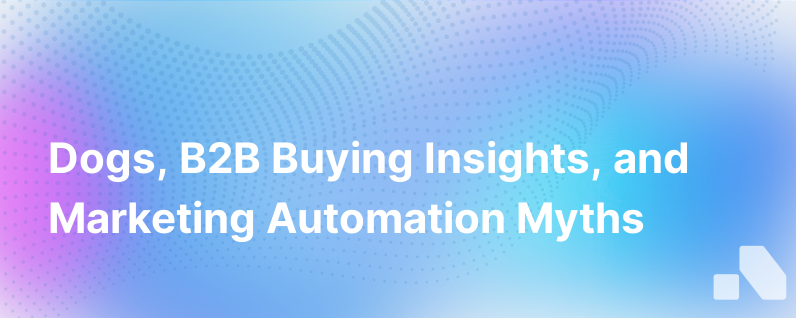
In today’s fast-paced digital environment, companies are increasingly relying on marketing automation to drive B2B sales and marketing efforts. On the surface, it appears to be a smart move: who wouldn't want to streamline their processes, improve efficiency, and reduce manual work? However, there’s a vital element missing from this equation - the complex nature of B2B buying groups. Surprisingly, we can learn a lot about addressing this complexity from an unlikely source: dogs.
Before you dismiss the idea as far-fetched, consider this - dogs excel in areas where marketing automation often fails: understanding group dynamics, reacting to subtle cues, and forming genuine relationships. Let's explore why marketing automation might be the wrong approach for B2B sales and uncover the lessons dogs can teach us about managing B2B buying group data effectively.
Marketing Automation: The B2B Disconnect
Marketing automation tools were designed primarily with B2C interactions in mind, where buying decisions are typically made by individuals, and the path to purchase is relatively straightforward. However, B2B purchases involve a web of stakeholders, each with their roles, influences, and decision-making power within a company. This complexity doesn't lend itself to the one-size-fits-all approach that marketing automation offers.
A standard marketing automation sequence may fail to consider:
- The various stakeholders involved in the B2B buying process
- Different pain points, perspectives, and motivations of each member within a buying group
- The non-linear progression of B2B sales cycles
- Interpersonal dynamics and decision-making hierarchies B2B sales require a nuanced approach that can only be partially achieved through automation.
What Dogs Can Teach Us About B2B Buying Groups
The lessons we learn from dogs about social intelligence, adaptability, and emotional understanding are incredibly relevant to navigating B2B buying groups.
Observing Social Dynamics
Dogs are astute observers of social dynamics within a group. They know when to approach, when to stay back, and how to interact with each member of the group. Similarly, B2B marketers need to understand the social dynamics within buying groups. By observing how individuals engage with content and each other, you can tailor your communications to resonate with each member and adjust strategies based on their reactions.
Adaptation and Learning
A dog’s ability to adapt to new environments and learn from experience is unmatched. In B2B buying groups, roles and concerns may shift as the buying journey progresses. Marketers need to adapt their messaging and tactics to these changes. Just as a dog learns from its environment, marketers must continuously collect data on buying group behavior and preferences, updating their strategies accordingly.
Building Relationships
Dogs are renowned for their ability to form bonds. Authentic relationships built on trust are also at the heart of successful B2B sales. Buying group members are more likely to consider vendors who not only understand their needs but also value the human connection – much like a dog does with its owner.
The Call for a More Tailored Approach
Drawing inspiration from the nuanced behavior of dogs, B2B marketers should seek to implement strategies that are as agile and emotionally intelligent as our four-legged friends. Here's a suggested approach to enhance B2B buying group data management:
Use Data Intelligently: Leverage analytics to gain insights into the behaviors of individual buying group members and the group as a whole. But don't just rely on data; interpret it in the context of human relationships.
Embrace Account-Based Marketing (ABM): Unlike the broad brushstrokes of marketing automation, ABM paints a detailed picture of each key account, focusing marketing efforts on individual buying groups within a targeted set of companies.
Focus on Relationship-Building: Personalize your outreach to individual group members, understanding their unique business concerns and how your solution can address them. Engage in genuine conversations and offer valuable, relevant content.
Be Agile: B2B buying is not a rigid process. Be prepared to pivot your strategy as conditions change, much like a dog adjusts its approach when sensing shifts in group dynamics.
Collaborative Selling: Ensure that your sales and marketing teams work together to understand and map the buying group. Sales often have direct insights that marketing teams can employ in their efforts for a cohesive approach.
The Contrast: Human Insight vs. Automation
Marketing automation lacks the human element required to effectively engage with B2B buying groups. It can't replicate the understanding a B2B salesperson develops after months of conversations and interactions with different stakeholders.
However, it's important to acknowledge that automation isn't all bad for B2B – it actually plays a crucial role in handling repetitive tasks and managing vast amounts of data. But the key to successful B2B marketing is knowing when to automate and when to personalize.
Conclusion:
The nuanced and complex nature of B2B buying processes demands a much more human approach, one that can be inspired by the social savvy of dogs. Automation tools can certainly aid in managing the data and facilitating repeated outreach, but they are not equipped to handle the intricacies of the B2B buying group dynamics.
To thrive in B2B sales, one must blend the efficiency of automation with the insights gleaned from account-based marketing and personalized human engagement. By observing, adapting, and forming relationships as canines do, marketers can navigate the labyrinth of B2B buying groups with finesse and empathy, achieving success not just for a moment but for long-term fruitful relationships.